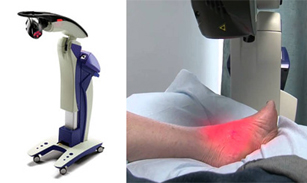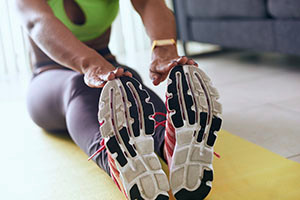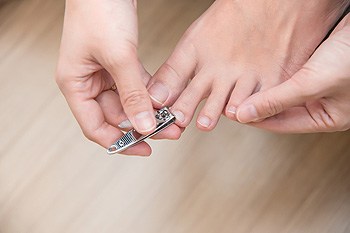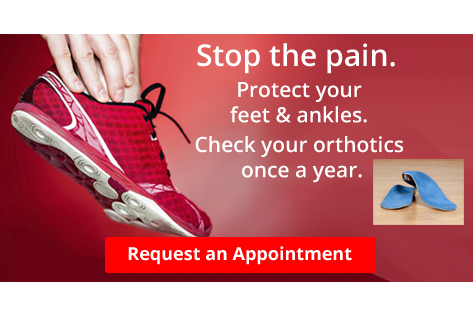October 2019
Reminder: When was the last time...?
MLS Laser Therapy
MLS Laser Therapy
MLS Laser Therapy is an FDA-approved technology designed to treat various painful conditions. It is often sought out as a successful alternative to surgical treatment and prescription medication that may otherwise bring about negative side effects. During MLS Laser Therapy, light energy enters the damaged cells to stimulate intercellular activity, reducing pain in the affected area and accelerating the recovery process.
MLS Laser Therapy is used in podiatry to treat various conditions. These include heel pain, plantar fasciitis, sports injuries, wounds, Achilles tendonitis, arthritis, neuromas, neurological pain, musculoskeletal disorders, and sore muscles. Aside from the specific conditions MLS Laser Therapy treats, patients can also gain from the treatment’s general benefits. These benefits include a rapid relief of pain, the reduction of swelling caused by inflammation or bruising, faster healing, improved blood circulation, the reduction of scar tissue, and improved nerve function.
MLS Laser Therapy is a non-surgical treatment with no side effects. The treatment process is painless and typically takes a short amount of time to complete. Several treatments may be required depending on the specific condition.
MLS Laser Therapy May Help Chronic Foot Pain
 Relief may be found from chronic foot conditions by using a technique that is referred to as MLS Laser Therapy. It is administered by emitting a certain amount of light to the affected area. Research has indicated that it may be effective in reducing pain and repairing damaged cells. It can be beneficial in treating muscles that are sore, and injuries that have occurred to the ligaments and tendons. The average treatment time can be up to ten sessions. Typically, positive results can be seen as the treatments are given. If you are experiencing chronic and debilitating foot pain, it is advised that you speak to a podiatrist who can help you in determining if MLS Laser Therapy is correct for you.
Relief may be found from chronic foot conditions by using a technique that is referred to as MLS Laser Therapy. It is administered by emitting a certain amount of light to the affected area. Research has indicated that it may be effective in reducing pain and repairing damaged cells. It can be beneficial in treating muscles that are sore, and injuries that have occurred to the ligaments and tendons. The average treatment time can be up to ten sessions. Typically, positive results can be seen as the treatments are given. If you are experiencing chronic and debilitating foot pain, it is advised that you speak to a podiatrist who can help you in determining if MLS Laser Therapy is correct for you.
MLS Laser Therapy is a successful alternative for treating any pain you may be experiencing related to certain podiatric conditions. If you are interested in MLS Laser Therapy, consult with Dr. Craig Campbell from Salt Lake City, Utah. Our doctor will assess your condition and provide you with quality foot and ankle treatment.
MLS Laser Therapy
Multiwave Locked System (MLS) Laser Therapy is a patented, FDA-cleared technology that helps relieve pain and inflammation from a number of podiatric conditions, including:
- Heel Pain
- Plantar Fasciitis
- Sports Injuries
- Wounds
- Achilles Tendonitis
- Arthritis
- Neuropathy
- Neuromas
MLS Laser Therapy is an ideal alternative to surgery and prescription medication, as it has no negative side effects and encourages accelerated healing. Among its many clinical benefits, MLS Laser Therapy also:
- Reduces swelling due to bruising or inflammation
- Blocks pain
- Reduces formation of scar tissue
- Improves nerve function
If you have any questions, please feel free to contact our office located in Salt Lake City, UT. We offer the newest diagnostic and treatment technologies for all your foot care needs.
Read more about MLS Laser TherapyPreventing Running Injuries
Over half of all runners encounter at least one injury per year. The reason for this is because many runners do not train properly. Injuries are almost inevitable due to the physical stress that running causes. While our bodies are great at adapting to the stress, it can only handle it in small doses. Injuries occur when the stress is applied too quickly for the body to handle, causing something within it to break down. With each step you take, your leg is absorbing two or three times your body’s weight.
Some of the most popular running injuries are shin splints, plantar fasciitis, Achilles tendinitis, and stress fractures. Shin splints cause pain along the inside or outside of the shins, and this pain is usually felt at the beginning of a run. The condition itself is defined as an inflammation of the muscles or tendons located around the shinbone. To treat shin splints, it is advised that you ice the shin area and stretch the calf muscles. To prevent this injury, you should slowly increase the distance you plan on running, instead of jumping into a more strenuous routine.
Achilles tendinitis is another common injury and it feels like pain along the back of the leg, toward the heel. This condition is defined as an inflammation of the Achilles which is the largest tendon in the body. The Achilles is responsible for connecting your calf muscles to the heel bone and it is caused by tight calf muscles. If you want to treat this injury, you should take a break from running to cross train with a low-impact activity.
There are a lot of common mistakes runners make that are causing them to experience injury. One mistake is stretching too much prior to warming up. If you plan to go on a run, you should warm up with a gentle 3-5-minute walk followed by a 5-minute run-walk. Another common mistake is jumping into a routine too quickly. Consequently, you should incorporate cross-training into your routine. If you are looking to get active, you should slowly weave running into an activity you are currently participating in. For example, you can try bike riding for 40 minutes followed by a 10-minute run.
Another way to prevent running injuries is to choose shoes that are appropriate for running. There are certain things you should look for when buying a new pair of running shoes. An important factor in these sneakers is flexibility. Running shoes should be capable of bending and flexing at the forefoot. However, you should not be able to bend the entire shoe in half with ease because this is a sign that the shoe does not have enough structure. Additionally, you should look for the fit of the running shoes you want to purchase. It is best to visit a specialty running shoe store to have your feet properly sized. Choosing shoes that fit properly can prevent many foot ailments.
If you are suffering from any pain from running injuries, you should make an appointment with your podiatrist to discover the underlying cause of your pain. He or she will be able to help treat your condition in the best way possible.
The Importance of Warming Up and Cooling Down
 The majority of people who enjoy the sport of running and jogging are aware of the importance of properly warming up before beginning their practice. It is important to keep the muscles limber and flexible, and this may be beneficial in preventing running injuries. It is equally as important to perform cool down stretches, and this may be helpful in preventing muscle soreness the following day. Research has indicated it is wise to follow a training plan. This can consist of gradually increasing the mileage and speed of your workout as to avoid strained muscles. Many runners incorporate strength training into their running routine, in addition to cross training activities. If you would like additional information about how running injuries can affect the feet, please consult with a podiatrist.
The majority of people who enjoy the sport of running and jogging are aware of the importance of properly warming up before beginning their practice. It is important to keep the muscles limber and flexible, and this may be beneficial in preventing running injuries. It is equally as important to perform cool down stretches, and this may be helpful in preventing muscle soreness the following day. Research has indicated it is wise to follow a training plan. This can consist of gradually increasing the mileage and speed of your workout as to avoid strained muscles. Many runners incorporate strength training into their running routine, in addition to cross training activities. If you would like additional information about how running injuries can affect the feet, please consult with a podiatrist.
All runners should take extra precaution when trying to avoid injury. If you have any concerns about your feet, contact Dr. Craig Campbell of Salt Lake City, Utah. Our doctor will treat your foot and ankle needs.
How to Prevent Running Injuries
There are a lot of mistakes a runner can make prior to a workout that can induce injury. A lot of athletes tend to overstretch before running, instead of saving those workouts for a post-run routine. Deep lunges and hand-to-toe hamstring pulls should be performed after a workout instead of during a warmup. Another common mistake is jumping into an intense routine before your body is physically prepared for it. You should try to ease your way into long-distance running instead of forcing yourself to rush into it.
More Tips for Preventing Injury
- Incorporate Strength Training into Workouts - This will help improve the body’s overall athleticism
- Improve and Maintain Your Flexibility – Stretching everyday will help improve overall performance
- “Warm Up” Before Running and “Cool Down” Afterward – A warm up of 5-10 minutes helps get rid of lactic acid in the muscles and prevents delayed muscle soreness
- Cross-Training is Crucial
- Wear Proper Running Shoes
- Have a Formal Gait Analysis – Poor biomechanics can easily cause injury
If you have any questions, please feel free to contact our office located in Salt Lake City, UT. We offer the newest diagnostic and treatment technologies for all your foot care needs.
Read more about Preventing Running InjuriesEvery Day Foot Care
Our feet are important in our everyday lives. The problem is that we tend to neglect them. When this becomes a habit, it can cause significant trouble. Ignoring foot problems can mean pain, limited mobility, and expensive doctor's visits. On the other hand, if feet are cared for and looked after regularly, they will perform without pain or complication.
Routine hygiene is the most basic way to care for the feet. Wash and dry them thoroughly daily. Remember to get between the toes and keep the toenails trimmed and short. If the feet feel dry or there are signs of dryness or cracking, use a moisturizer designed for the feet.
When using moisturizer on the feet, try to avoid applying between the toes. If cream or lotion sits too long, they can cause fungal and bacterial growth. When moisturizer is used between the toes, it can also cause the skin to soften too much.
Shoes are also an important aspect of foot care. When one is picking out shoes, make sure they are the correct size. Shoes need to be snug, but not too tight. On the other hand, if shoes are too loose they can cause foot problems as well. It is highly recommended that shopping for new shoes be done later in the day. The reason for this is that the feet will have settled and swelled to their full size by then. To keep your feet at their most healthy, avoid wearing high heels or flip flops too often. Instead, choose shoes that are good for your feet. Good shoes pad the soles of your feet and support the arches and ankles.
Socks should also be worn daily with closed-toe shoes. They may feel hot during the summer months, but they absorb sweat and moisture off the feet. Without socks, the build-up of sweat in a closed-toe shoe can cause fungal problems and athlete's foot.
The best thing to remember in every day foot care is that shoes do make a difference. If you spend a lot of time on your feet, make sure that your shoes show no signs of wear. Shoes should offer ample support for the arches and the overall foot. Additionally, try to make foot cleaning and maintenance a daily habit. If you keep these things in mind, your feet will stay healthy and safe.
Proper Foot Care May Prevent Unwanted Foot Conditions
 The feet are considered to be the foundation of the body. It is important to take care of them in the best way possible. There are daily routines that can be implemented which can help the feet, and positively affect the overall health of the body. These can include washing and drying the feet thoroughly, followed by using a moisturizer. This aids in keeping the skin soft, and may prevent unwanted foot conditions from developing. Additionally, it is beneficial to wear shoes that fit properly. These can consist of choosing shoes that have adequate room for the toes to move freely in, and ensuring the shoes are constructed with breathable materials. It may be helpful to avoid wearing high heels, or to wear them for limited periods of time, which may help to prevent hammertoe and bunions from developing. Research has indicated the importance of trimming the toenails correctly, as this is known to play a significant role in preventing ingrown toenails from developing. If you would like additional information about how to properly take care of your feet, please consult with a podiatrist.
The feet are considered to be the foundation of the body. It is important to take care of them in the best way possible. There are daily routines that can be implemented which can help the feet, and positively affect the overall health of the body. These can include washing and drying the feet thoroughly, followed by using a moisturizer. This aids in keeping the skin soft, and may prevent unwanted foot conditions from developing. Additionally, it is beneficial to wear shoes that fit properly. These can consist of choosing shoes that have adequate room for the toes to move freely in, and ensuring the shoes are constructed with breathable materials. It may be helpful to avoid wearing high heels, or to wear them for limited periods of time, which may help to prevent hammertoe and bunions from developing. Research has indicated the importance of trimming the toenails correctly, as this is known to play a significant role in preventing ingrown toenails from developing. If you would like additional information about how to properly take care of your feet, please consult with a podiatrist.
Everyday foot care is very important to prevent infection and other foot ailments. If you need your feet checked, contact Dr. Craig Campbell from Salt Lake City, Utah. Our doctor can provide the care you need to keep you pain-free and on your feet.
Everyday Foot Care
Often, people take care of their bodies, face and hair more so than they do for their feet. But the feet are a very important aspect of our bodies, and one that we should pay more attention to. Without our feet, we would not be able to perform most daily tasks.
It is best to check your feet regularly to make sure there are no new bruises or cuts that you may not have noticed before. For dry feet, moisturizer can easily be a remedy and can be applied as often as necessary to the affected areas. Wearing shoes that fit well can also help you maintain good foot health, as well as making it easier to walk and do daily activities without the stress or pain of ill-fitting shoes, high heels, or even flip flops. Wearing clean socks with closed shoes is important to ensure that sweat and bacteria do not accumulate within the shoe. Clean socks help to prevent Athlete’s foot, fungi problems, bad odors, and can absorb sweat.
If you have any questions please feel free to contact our office located in Salt Lake City, UT. We offer the newest diagnostic and treatment technologies for all your foot and ankle needs.
Read more about Every Day Foot CareHeel Pain
Have you ever gotten up from a chair or out of bed in the morning, and upon taking that first step, feel like your heel has stepped on a tack? Many people experience a feeling of sharp pain which radiates into their arch from their heel and which does not allow them to put their heel on the floor. Sometimes they need to sit back down, stand only on their toes and use the wall for balance. If you can take a few steps, it seems to go away and lessen, allowing you to then resume your activity. Later, throughout your day and after a period of rest, it can happen again. If this sounds familiar you may be suffering from your first attack of heel pain.
Heel pain is a debilitating condition that affects day to day activities. Running and walking both causes stress on the heel because the heel is the part of the foot that hits the ground first. This means that the heel is taking on your entire weight. Diagnosis and treatments for heel pain can be easily found through your podiatrist.
Plantar Fasciitis
One of the main causes of heel pain is a condition known as plantar fasciitis. The plantar fascia is a band of tissue that extends along the bottom of the foot, from the toe to the bottom of the heel. A rip or tear in this ligament can cause inflammation of these tissues, resulting in heel pain. People who do not wear proper fitting shoes are often at risk of developing problems such as plantar fasciitis. Unnecessary stress from ill-fitting shoes, weight change, excessive running, and wearing non-supportive shoes on hard surfaces are all causes of plantar fasciitis.
Achilles Tendonitis
Achilles tendonitis is another cause of heel pain. Similar to plantar fasciitis, inflammation of the Achilles tendon will cause heel pain due to stress fractures and muscle tearing. A lack of flexibility of the ankle and heel is an indicator of Achilles tendonitis. If left untreated, this condition can lead to plantar fasciitis and cause even more pain on your heel.
Heel Spur
A third cause of heel pain is a heel spur. A heel spur occurs when the tissues of the plantar fascia undergo a great deal of stress, leading to a separation of the ligament from the heel bone entirely. This results in a pointed fragment of bone on the ball of the foot, known as a heel spur.
Why Do I Have Heel Pain?
 Heel pain is a common ailment among many people. It may be a foot condition that is more prevalent among specific groups of people. These may include individuals who are obese, people who participate in sporting activities, or women who are pregnant. Additionally, heel pain may develop from wearing shoes that do not fit correctly, or if there has been an injury to the heel. Patients who have medical conditions that include plantar fasciitis or heel spurs are familiar with the heel pain that is often associated with these ailments. There are methods that can be implemented which may provide moderate relief. These can consist of wearing custom made orthotics, resting the heel, and performing specific flexibility stretches. If you have any type of heel pain, it is strongly suggested that you consult with a podiatrist who can properly diagnosis and treat this condition.
Heel pain is a common ailment among many people. It may be a foot condition that is more prevalent among specific groups of people. These may include individuals who are obese, people who participate in sporting activities, or women who are pregnant. Additionally, heel pain may develop from wearing shoes that do not fit correctly, or if there has been an injury to the heel. Patients who have medical conditions that include plantar fasciitis or heel spurs are familiar with the heel pain that is often associated with these ailments. There are methods that can be implemented which may provide moderate relief. These can consist of wearing custom made orthotics, resting the heel, and performing specific flexibility stretches. If you have any type of heel pain, it is strongly suggested that you consult with a podiatrist who can properly diagnosis and treat this condition.
Many people suffer from bouts of heel pain. For more information, contact Dr. Craig Campbell of Salt Lake City, Utah. Our doctor can provide the care you need to keep you pain-free and on your feet.
Causes of Heel Pain
Heel pain is often associated with plantar fasciitis. The plantar fascia is a band of tissues that extends along the bottom of the foot. A rip or tear in this ligament can cause inflammation of the tissue.
Achilles tendonitis is another cause of heel pain. Inflammation of the Achilles tendon will cause pain from fractures and muscle tearing. Lack of flexibility is also another symptom.
Heel spurs are another cause of pain. When the tissues of the plantar fascia undergo a great deal of stress, it can lead to ligament separation from the heel bone, causing heel spurs.
Why Might Heel Pain Occur?
- Wearing ill-fitting shoes
- Wearing non-supportive shoes
- Weight change
- Excessive running
Treatments
Heel pain should be treated as soon as possible for immediate results. Keeping your feet in a stress-free environment will help. If you suffer from Achilles tendonitis or plantar fasciitis, applying ice will reduce the swelling. Stretching before an exercise like running will help the muscles. Using all these tips will help make heel pain a condition of the past.
If you have any questions please contact our office located in Salt Lake City, UT. We offer the newest diagnostic and treatment technologies for all your foot and ankle needs.
Read more about Heel PainEffect of High Heels on the Feet
High heels are uncomfortable, but many women sacrifice comfort to be stylish. There are many problems that stem from wearing high heels, however these issues can be avoided by wearing proper shoes.
Heels are bad because they push your weight forward toward the fall of the foot. The higher the heel is, the more weight and pressure get shifted. This process causes the back to hyperextend backwards to counterbalance which may cause pain in the leg, hip, and back. Consequently, major posture problems may occur, and these issues may eventually become permanent.
Wearing high heels is one of the leading cause of ingrown toenails. Heels create a great deal of pressure on the big toenails which disrupts proper toenail growth. This may eventually lead to the big toenail growing into the skin. Another common problem that stems from high heels is bunions. If bunions go untreated, they can cause serious scar tissue to form along with severe pain.
However, there are ways to minimize the harmful risks associated with wearing heels. You should try to massage and stretch your legs and feet after wearing heels for an extended time. Stretching helps prevent the Achilles tendons and calf muscles from becoming too tight. A good substitute for heels are platforms which provide a better surface area to evenly distribute the body’s weight.
If you are experiencing any painful foot conditions from wearing high heels, you should consult with your podiatrist right away.







